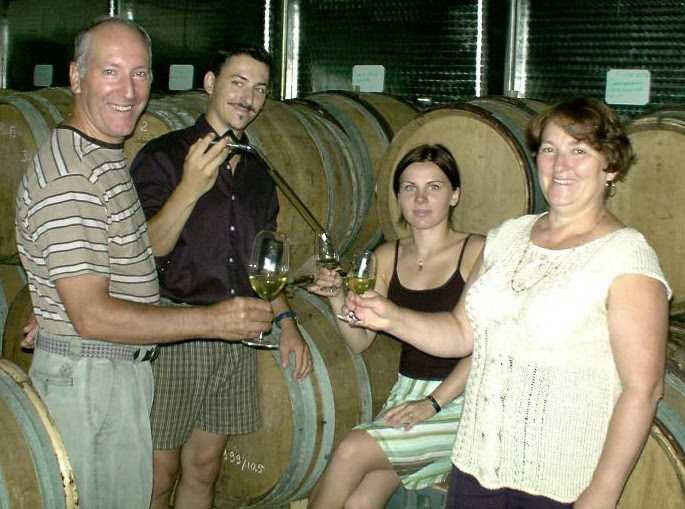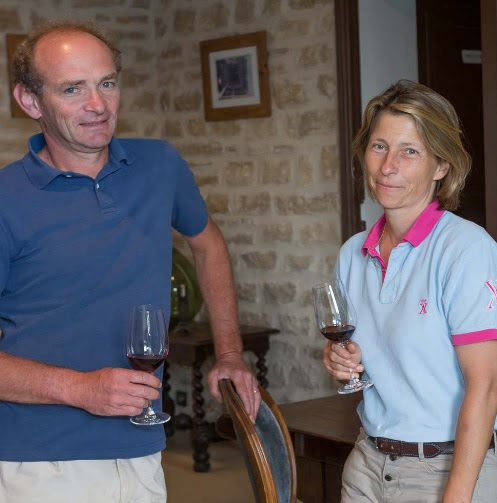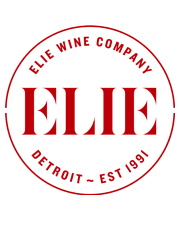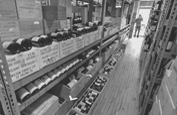Pure & Succulent Chardonnay from Burgundy’s Viré-Clessé
The Mâconnais region of southern Burgundy is white wine country and the Chardonnay variety is particularly at home on these limestone slopes with just a bit more warmth than the Côte d’Or.
 One of the top producers in the region, third generation winemaker Jean-Marie Chaland, owns a little over 20 acres of vineyards mostly planted with vines aged 50 to 100 years old in and around Viré-Clessé. With organic certification since 2006, fermentation with indigenous yeast, and only the top cuvées maturing in a tiny proportion of new oak barrels, Jean-Marie’s wines are pure, complex, and expressing all of the fleshiness of this unique subzone.
One of the top producers in the region, third generation winemaker Jean-Marie Chaland, owns a little over 20 acres of vineyards mostly planted with vines aged 50 to 100 years old in and around Viré-Clessé. With organic certification since 2006, fermentation with indigenous yeast, and only the top cuvées maturing in a tiny proportion of new oak barrels, Jean-Marie’s wines are pure, complex, and expressing all of the fleshiness of this unique subzone.
The composite of two top communes in the Mâconnais, Viré-Clessé was recognized in the late 1990s with appellation status for its superior quality Chardonnay-based wines. What makes Viré-Clessé so special is a combination of chalky clay soil over limestone as well as hillside vineyards with favorable exposition to the sun. In the right hands the result are wines plump with fruit yet balanced by a streak of minerality. At their best, they are as close to a properly matured Côte de Beaune white you can get for a fraction of the price and without spending years in a cellar.
The wines of Jean-Marie Chaland are fresh, well-balanced, and joyful. From the easy drinking Mâcon-Villages to the complex single-vineyard, old-vine Viré-Clessé to the elegantly sparkling Crémant, Jean-Marie’s wines all offer heady aromatics and typicity of place.
The holidays are closing in fast and the crowd-pleasing, food-friendly wines of Jean-Marie Chaland are an ideal addition to any gathering.
The Wines of Jean-Marie Chaland
All prices based on the purchase of a 6-pack (mix-and-match)
![]() ~$33 Domaine Sainte Barbe “ Perle de Roche” (Crémant de Bourgogne Brut Nature) SPARKLING
~$33 Domaine Sainte Barbe “ Perle de Roche” (Crémant de Bourgogne Brut Nature) SPARKLING
From a parcel of 45 year old vines on a shallow limestone slab in the commune of Viré. The bottles are cellared for two to three years before disgorgement. No dosage is added. The wine is only produced once every two years for a total of about 3,200 bottles.
![]() ~$22 Domaine Sainte Barbe “Les Tilles” (Mâcon-Villages 2016)
~$22 Domaine Sainte Barbe “Les Tilles” (Mâcon-Villages 2016)
From a 3.75 acre plot of vines planted in the late 1960s situated on the silty, clay-limestone plateau of Montbellet. It is fermented with indigenous yeast and matured on fine lees for eight months in stainless steel tanks. 3,000 bottles produced.
![]() ~$25 Domaine des Chazelles “Vieilles Vignes” (Viré-Clessé 2016)
~$25 Domaine des Chazelles “Vieilles Vignes” (Viré-Clessé 2016)
From a five acre plot of 60+ year old vines that’s well protected from prevailing winds, allowing an advanced ripeness.
![]() ~$32 Domaine Sainte Barbe “L’Epinet” (Viré-Clessé 2016)
~$32 Domaine Sainte Barbe “L’Epinet” (Viré-Clessé 2016)
From a 1.75 acre plot planted in 1940 on a southeast facing hilltop in the commune of Clessé. Fermentation and aging on lees in barrels for one year (with only one new barrel added per year). 4,500 bottles produced.
![]() ~$38 Domaine Sainte Barbe “Thurissey” (Viré-Clessé 2016)
~$38 Domaine Sainte Barbe “Thurissey” (Viré-Clessé 2016)
From a gently sloping, southeast facing 1.3 acre plot of 95+ year old vines in the northern zone of Viré-Clessé. Fermentation and aging on lees in barrels for one year (with only one new barrel added per year). 2,000 bottles produced.
- - -
Posted on 2018.10.17 in France, Saturday Sips Wines, Burgundy | Read more...
Beguiling Provençal Wines from a Virtuoso of the Vine
The appellation of Les Baux-de-Provence is unmistakably Provençal. Between olive groves and pine forests the rocky landscape is wild with the fragrant garrigue that marks its wines. Although the appellation is small and relatively new, the handful of winemaking estates there have earned well-deserved praise for their farming practices. As much as 85% of the area is devoted to an organic or biodynamic approach. It is the home of perhaps the most well-regarded estate in all of Provence, Domaine de Trévallon.
 Not far behind Domaine de Trévallon in stature is Dominique Hauvette. In the early 1980s Dominique left her job as a lawyer in the Savoie, began studying oenology, and eventually amassed a little over 40 acres of vineyards along with an international reputation for producing model Provençal wines.
Not far behind Domaine de Trévallon in stature is Dominique Hauvette. In the early 1980s Dominique left her job as a lawyer in the Savoie, began studying oenology, and eventually amassed a little over 40 acres of vineyards along with an international reputation for producing model Provençal wines.
Domaine Hauvette is situated at the foot of Les Alpilles mountain range outside Saint Rémy-de-Provence, a small commune perhaps most famous for a little painting called “The Starry Night” that was created by Vincent van Gogh as he was being treated in the psychiatric center at Monastery Saint-Paul de Mausole. As the crow flies it’s about 15 miles from Châteauneuf-du-Pape in the southern Rhône. Indeed, the Rhône River is just a few minutes away by car.
The limestone foothills of Les Alpilles create a distinct landscape and microclimate. The soils retain moisture during the arid summer months, the legendary Mistral wind cools the vines and expels mold-fostering humidity, and Les Alpilles buffer the vines from potential damage.
Dominique began converting to biodynamic cultivation in 2000 with the goal of growing ideal fruit. At harvest, grapes are picked by hand and sorted in the field. She employs minimal intervention in the cellars, fermenting with indigenous yeasts. Many of her wines are fermented and aged in concrete eggs that allow a continuous flow of liquid during the process as well as stabilize temperature.
The Wines of Domaine Hauvette
All prices based on the purchase of a 6-pack (mix-and-match)
![]() ~$34 “Jaspe” (IGP Alpilles Blanc 2016)
~$34 “Jaspe” (IGP Alpilles Blanc 2016)
From a five acre plot of Rousanne with an average age of 15 years. Cuvée “Jaspe” is fermented in cement eggs and aged briefly in stainless steel tank.
![]() ~$53 “Dolia” (IGP Alpilles Blanc 2013)
~$53 “Dolia” (IGP Alpilles Blanc 2013)
A field blend of equal portions Roussanne, Marsanne, and Clairette from a 1.7 acre plot with an average age of 23 years. Cuvée “Dolia” is fermented and aged in cement eggs.
![]() ~$44 “Cornaline” (Les Baux-de-Provence 2011)
~$44 “Cornaline” (Les Baux-de-Provence 2011)
A blend of 50% Grenache, 30% Syrah, and 20% Cabernet Sauvignon from vines with an average age of 40 years. Cuvée “Cornaline” is fermented in wood tanks and aged in foudre.
![]() ~$80 “Améthyste” (IGP Alpilles Rouge 2015)
~$80 “Améthyste” (IGP Alpilles Rouge 2015)
It’s rare to find a wine this ambitious made predominantly of Cinsault. 60% Cinsault, 30% Carignan, and 10% Grenache from vines with an average age of 40 years. Cuvée “Améthyste” is fermented in wood tanks and aged in cement eggs.
![]() ~$117 “Compendium” (Vin de France 2007)
~$117 “Compendium” (Vin de France 2007)
A truly special Roussane-based dessert wine elaborated by the passerillage method of desiccating the grapes to concentrate sugars much like the great Vin de Paille (straw wine) of Hermitage. Cuvée “Compendium” is only made in vintages that have the optimum conditions to create this type.
- - -
Posted on 2018.10.11 in France, Saturday Sips Wines, Provence | Read more...
Corsican Beauties
Dry farming is a bit of a buzzword when talking about fruit quality in New World wines but for most of Europe’s classic grape-growing regions dry farming is obligatory because irrigation is illegal. This is possibly at its most extreme in the dry, scrub-covered landscape of Corsica’s Desert des Agriates. It is there, in the appellation of Patrimonio, that the isolated estate of Domaine Giacometti coaxes wonderfully balanced wines from this rugged swath of land on the northern end of the island near the tiny hamlet of Casta.
While one might expect wines from such a hot and arid place to express as overripe, in the right hands the wines can be models of freshness and grace with a subtle herbality whispering of the mints, laurels, and myrtles of the aromatic maquis shrubland that blankets the coast.
There are two driving characteristics of the Casta climat that help shape the unique expression of terroir in Giacometti’s wines. First is the granite and clay soils that impart elegance and delicacy to the wines.  The second is a steady wind called the Libecciu, most prominent during the summer. This wind not only moderates the temperatures during the heat of the growing season, it also helps reduce the risk of disease in the vineyards.
The second is a steady wind called the Libecciu, most prominent during the summer. This wind not only moderates the temperatures during the heat of the growing season, it also helps reduce the risk of disease in the vineyards.
Laurent Giacometti purchased the domaine in 1987 with his son, Christian, taking over vines that had been planted in 1966. Today it is the 3rd generation of Giacomettis, Simon and Sarah, that run the operation. The first goal of the estate is to create wines that express place. To accomplish this lofty pursuit the family focuses on organic farming and minimal intervention in the cellars. They are succeeding. With a nod to the old pudding proverb: The proof of the wine is in the drinking.
All prices based on the purchase of a 6-pack (mix-and-match)

$18 SOLD OUT “Cru des Agriate” (Patrimonio Rouge 2015)
97% Niellucciu and 3% Grenache fermented with indigenous yeasts and then aged for 10 months on fine lees in stainless steel tank. While the grape variety Niellucciu is thought to be a strain of Sangiovese likely introduced to the island by the Genoese sometime around the 13th century, it has clearly been adapted to Corsica. “Cru des Agriate” exudes a heady bouquet of herbal maquis and lusty flowers over smoky cherry fruit. A sip is ripe, juicy, and downright poundable, finishing with a twist of pomegranate sap. It’s like a staid Chianti Classico went on a Mediterranean sailing vacation and came back with a shaggy beard and suntan – easily one of the most expressive under $20 wines available.
 $27 “Sempre Azezzu” (Vin de France Rouge 2015)
$27 “Sempre Azezzu” (Vin de France Rouge 2015)
100% Syrah fermented with indigenous yeasts and then aged for 12 months on fine lees in 500 liter barrels. While the Giacomettis mostly like to work with the regional varieties, they chose to plant a tiny plot of less than one acre of Syrah with the aim of producing a wine with the unique expression of Casta within the frame of an international grape variety. Along with a varietal purity in the aromatics and on the palate, “Sempre Azezzu” hints at the herbal maquis of the island while oozing generous aromas of bright fruit, flowers, and spice. A sip is lively and fresh with wild berries and a lengthy mineral finish. In a blind tasting this wine might be confused with an approachable version of Northern Rhône’s Saint-Joseph, also known for its granite soils.
- - -
Posted on 2018.10.03 in France, Saturday Sips Wines, Corsica | Read more...
The Champagne Society – October 2018 Selection: Champagne Serge Mathieu
Champagne Serge Mathieu Brut Prestige OR Brut Rosé
Price for The Champagne Society members: $65
The Aube region forms the southernmost part of Champagne, closer to the vineyards of Chablis than to the bulk of Champagne vineyards of the Marne. The area is known for wines of ripeness and generous fruit. To discover wines that wholly represent the region look no further than the grower/producer Serge Mathieu. This small estate produces less than 10,000 cases a year yet has been firmly established as one of the best producers in the Aube today.
 The Mathieus have been growers in the Aube since at least 1760. They are seven generations of farmers that began by selling their grapes to négociant houses, eventually accumulating an estate that now covers just over 27 acres. In 1970, Serge Mathieu took the family business to the next level, creating the first champagne bottled under the family name. Today it is his daughter Isabelle and her husband, Michel Jacob, who now run the business, practicing as close to a biodynamic program as the region will sustain.
The Mathieus have been growers in the Aube since at least 1760. They are seven generations of farmers that began by selling their grapes to négociant houses, eventually accumulating an estate that now covers just over 27 acres. In 1970, Serge Mathieu took the family business to the next level, creating the first champagne bottled under the family name. Today it is his daughter Isabelle and her husband, Michel Jacob, who now run the business, practicing as close to a biodynamic program as the region will sustain.
Champagne Serge Mathieu is based in the village of Avirey-Lingey, one of the smallest wine-growing communes in the Aube. This is the Côte des Bars, where slopes, soils, and climate are favorable to Pinot Noir, under the right hands producing highly expressive, balanced, and approachable wines.
Given the tiny production of Champagne Serge Mathieu we do not have enough of one single cuvée for all of our Champagne Society Members but we still wanted to share the best wines of the Aube with you. You will have a choice of either the Brut Prestige OR Brut Rosé as long as both are available.
![]() Champagne Serge Mathieu Brut Prestige
Champagne Serge Mathieu Brut Prestige
Brut Prestige is a blend of around 65% Pinot Noir and 35% Chardonnay. The wine is aged for four years before disgorgement and finished with a dosage of 8.6 grams/liter. An elegant and delicate wine that could be described as the most feminine of the Serge Mathieu cuvées.
![]()
Champagne Serge Mathieu Brut Rosé
A blend of 90% Pinot noir and 10% Chardonnay, Brut Rosé is a traditional method rosé that is assembled using red wine from the estate and finished with a dosage of 9.5 grams/liter. It is a rosé of clearly defined fruit and crispness.
- - -
Posted on 2018.10.02 in France, The Champagne Society, Burgundy | Read more...
The Plump and Succulent Terroirs of Beaune
Established by Albert Morot in 1820, Domaine Albert Morot has risen to one of the leading properties in the Côte de Beaune. The estate consists of about 20 acres of vineyards, almost entirely in the Beaune Premiers Crus of Les Teurons, Les Gréves, Les Toussaints, Les Bressandes, Les Cent Vignes, Les Marconnets, and La Bataillére. The vineyards are planted mainly with Pinot Noir.
 The estate remains a family run operation. Geoffrey Choppin de Janvry has been responsible for the wines since 2000, when his aunt Françoise Choppin (great-granddaughter of Albert Morot) retired. While retaining the deep focus on quality started by his aunt in the 1980s, including green harvesting, double sorting during harvesting, and minimizing cellar interventions, Geoffroy has ushered the estate into a new era by gradually implementing organic farming methods.
The estate remains a family run operation. Geoffrey Choppin de Janvry has been responsible for the wines since 2000, when his aunt Françoise Choppin (great-granddaughter of Albert Morot) retired. While retaining the deep focus on quality started by his aunt in the 1980s, including green harvesting, double sorting during harvesting, and minimizing cellar interventions, Geoffroy has ushered the estate into a new era by gradually implementing organic farming methods.
Our featured wines from the 2015 vintage mark the domaine’s first year being completely certified organic. They are all vinified traditionally in open vats with indigenous yeasts. Aging takes place for 14 months in French oak barrels, 30% of which are new. There are few other estates that can represent the generous fruit and gentle elegance of the terroirs of Beaune as well as Domaine Albert Morot.
The 2015 Vintage Wines of Domaine Albert Morot
All prices based on the purchase of a 6-pack (mix-and-match)
![]() ~$53 “Aigrots” (Beaune Premier Cru)
~$53 “Aigrots” (Beaune Premier Cru)
Located next to the celebrated “Clos des Mouches” vineyard on the middle of the slope the “Les Aigrots” vineyard faces east. The stony soil of this 1.8 acre plot is rich in loam and clay, producing full-bodied, generous wines. The vines are between 29 and 37 years old.
![]() ~$53 “Les Cent Vignes” (Beaune Premier Cru)
~$53 “Les Cent Vignes” (Beaune Premier Cru)
The three acre plot of “Les Cent Vignes” (one hundred vines) is located at the bottom of the slope with a southeastern exposure and is composed mainly of loam and clay soils. The vines on this plot were planted in 1958 and are known for producing wines that are remarkable for their color and delicacy of aromas. On the palate the wines combine complexity and mellowness.
![]() ~$53 “Toussaints” (Beaune Premier Cru)
~$53 “Toussaints” (Beaune Premier Cru)
The southwest facing, two acre plot of “Les Toussaints” abuts “Les Cent Vignes” and has a soil combining loam, clay, and limestone. The vines on this plot were planted in 1969 and produce wines of rich, red fruit and charming complexity.
![]() ~$58 “Marconnets” (Beaune Premier Cru)
~$58 “Marconnets” (Beaune Premier Cru)
The 1.7 acre, southeast facing plot “Les Marconnets” is located upslope and extends into the commune of Savigny-lès-Beaune. The vines planted here on a limestone soil mixed with loam, sands and clay soils are as old as 70 years. The resulting wine reveal distinction, power, and aromatic complexity.
![]() ~$62 “Bressandes” (Beaune Premier Cru)
~$62 “Bressandes” (Beaune Premier Cru)
Wines from the limestone, loam, and clay soils of the southeastern exposed vineyard of “Les Bressandes” express a dense, bold body and beautiful silkiness. The surface is three acres and is planted with vines ranging in age from 12 years to 53 years old.
From the Cellar – Wines of Domaine Albert Morot
We have a limited number of Domaine Albert Morot wines from the 2002 and 2003 vintages available at the shop that show all the mature complexity and character of well-cellared Beaune wines.
$99 “Aigrots” (Beaune Premier Cru 2002) WHITE
$126 “Aigrots” (Beaune Premier Cru 2002) RED
$126 “Toussaints” (Beaune Premier Cru 2002)
$126 “Teurons” (Beaune Premier Cru 2002)
$126 “Bressandes” (Beaune Premier Cru 2003)
- - -
Posted on 2018.09.27 in Saturday Sips Wines, France, Burgundy | Read more...
Featured Wines
- Notebook: A’Boudt Town
- Saturday Sips Wines
- Saturday Sips Review Club
- The Champagne Society
- Wine-Aid Packages
Wine Regions
Grape Varieties
Aglianico, Albarino, Albarín Tinto, Albillo, Alicante Bouschet, Aligote, Altesse, Arbanne, Arcos, Auxerrois, Barbarossa, Beaune, Biancu Gentile, Bonarda, bourboulenc, Cabernet Sauvignon, Caladoc, Calvi, Carignan, Chablis, Chenin Blanc, Cinsault, Clairette, Cortese, Corvinone, Cot, Counoise, Dolcetto, Fiano, folle Blanche, Frappato, Fumin, Gamay, Garganega, Garnacha Tintorera, Godello, Graciano, Grenache, Grenache Blanc, Grolleau, Groppello, Jacquère, Juan Garcia, Lladoner Pelut, Macabeo, Maconnais, Malbec, Malvasia, Malvasia Nera, manseng, Marcelan, Marselan, Marzemino, Melon de Bourgogne, Mencía, Merlot, Montepulciano, Montònega, Mourv, Mourvèdre, Muscadelle, Muscat, Natural, Nebbiolo, Nero d'Avola, Niellucciu, Palomino, Patrimonio, Pecorino, Pedro Ximénez, Persan, Pineau d'Aunis, Pinot Auxerrois, Pinot Gris, Pinot Meunier, Pouilly Fuisse, Pouilly Loche, Poulsard, Riesling, Rose, Rousanne, Sagrantino, Sangiovese, Sauvignon, Sciacarellu, Serine, Souson, Sumoll, Tempranillo, Teroldego, Timorasso, Trebbiano Valtenesi, Treixadura, trepat, Trousseau, Ugni Blanc, Vermentino, Viognier, Viura, Xarel-loWines & Events by Date
- September 2025
- August 2025
- July 2025
- June 2025
- May 2025
- April 2025
- March 2025
- February 2025
- January 2025
- December 2024
- November 2024
- October 2024
- September 2024
- August 2024
- July 2024
- June 2024
- May 2024
- April 2024
- March 2024
- February 2024
- January 2024
- December 2023
- November 2023
- October 2023
- September 2023
- August 2023
- July 2023
- June 2023
- May 2023
- April 2023
- March 2023
- February 2023
- January 2023
- December 2022
- November 2022
- October 2022
- September 2022
- August 2022
- July 2022
- June 2022
- May 2022
- April 2022
- March 2022
- February 2022
- January 2022
- December 2021
- November 2021
- October 2021
- September 2021
- August 2021
- July 2021
- June 2021
- May 2021
- April 2021
- March 2021
- February 2021
- January 2021
- December 2020
- November 2020
- October 2020
- September 2020
- August 2020
- July 2020
- June 2020
- May 2020
- April 2020
- March 2020
- February 2020
- January 2020
- December 2019
- November 2019
- October 2019
- September 2019
- August 2019
- July 2019
- June 2019
- May 2019
- April 2019
- March 2019
- February 2019
- January 2019
- December 2018
- November 2018
- October 2018
- September 2018
- August 2018
- July 2018
- June 2018
- May 2018
- April 2018
- March 2018
- February 2018
- January 2018
- December 2017
- November 2017
- October 2017
- September 2017
- August 2017
- July 2017
- June 2017
- May 2017
- April 2017
- March 2017
- February 2017
- January 2017
- December 2016
- November 2016
- October 2016
- September 2016
- August 2016
- July 2016
- June 2016
- May 2016
- April 2016
- March 2016
- February 2016
- January 2016
- December 2015
- November 2015
- October 2015
- September 2015
- August 2015
- July 2015
- June 2015
- May 2015
- April 2015
- March 2015
- February 2015
- January 2015
- December 2014
- November 2014
- October 2014
- September 2014
- August 2014
- July 2014
- June 2014
- April 2014
- March 2014
- February 2014
- January 2014
- December 2013
- November 2013
- October 2013
- September 2013
- August 2013
- July 2013
- June 2013
- May 2013
- April 2013
- March 2013
- February 2013
- January 2013
- December 2012
- November 2012
- October 2012



